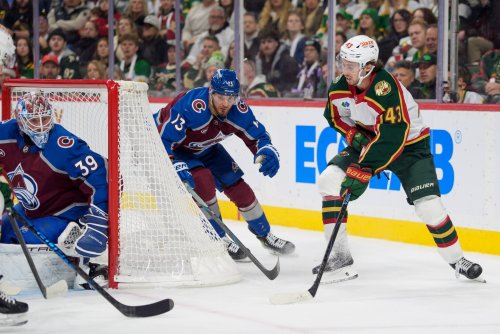
Depending on who you believe, face-offs could be one of the most or least important parts of the game. Some players (Mikko Koivu, for instance) are valued for their ability to win face-offs. Logic would tell us that face-offs are highly vital; if possession is ultimately the greatest predictor of success, wouldn't you want it right away?
Not so fast, others say. There are plenty of good teams who are less than successful at the dots. The New York Rangers, for instance, made it all the way to the finals with a 5v5 Close FO% of 49.2. Colorado was able to win the Central Division with a 5v5 Close FO% of 49.08.
So, what's the real story? Since possession is generally the measure of a team's quality, let's investigate to see if we can find a connection between the two. First, let's see what we know, and what research has been done already.
What Do We Know?
Winning face-offs is important. Pretty much anyone will tell you that, and the reasons are pretty obvious (so obvious that even Randy Carlyle gets it).
To say the Wild have struggled at the face-off dot this year is more than fair; for a generally successful face-off team, this year's numbers are pretty mediocre.
While never dominant, the Wild have not been a below-50% team since 2008-9. Yet, as Ger pointed out some time ago, the Wild have been a terrible puck-possession team historically. Nowadays, they are very good, possession-wise, yet are struggling in the dots.
Not much has been looked into just how much face-offs turn into possession, however. The Leafs Nation did determine that more zone time can be pretty strongly represented by Corsi Numbers, but didn't find a strong correlation between zone time and faceoffs.
Arctic Ice Hockey did some looking into shot-rates after faceoffs (twice). Hockey Analysis wrote an article about how Zone Starts affect Corsi, Fenwick, and the like for individual players. But there is nothing out there that I could find that, team-wide, connected Corsi to faceoffs. So, let's do that now.
Taking a sojourn over to www.war-on-ice.com (one of my new favorite stat sites), we have access to Corsi, Fenwick, and Face-off data dating back to 2002.
The Goal:
The goal here is: determine the connection between winning face-offs and higher CF%. Why? Simple: narratives dictate the importance of winning face-offs. Logically, that makes sense; if you gain the puck, you're more likely to take shots, right?
Let's find out.
5v5 Close
We'll start with the game state that most stats authorities consider to be the "best" in terms of representing actual ability.
Plugging the 5v5 Close numbers into my trusty calculator generates the following plot and trendline:
R2, for those who don't know (or it's been a while since stats class) is, effectively, a measure of the strength of a trendline (or any model for predicting data). You can learn more about it here. In our case, an R2 value of .17, is not particularly high. Basically, it means that the trendline only explains 17% of the variability in the data. This means that the other 83% of the variability is due to... something else.
Put simply, at 5v5 Close, winning face-offs does not correlate strongly at all to higher CF%. That doesn't mean a correlation doesn't exist, however. It's possible that 5v5 Close is simply too narrow a scope at which to look at this; possession exists in all score situations, so let's
5v5
Here is the same chart as above, only with at 5v5 in all score states:
Well, shoot. Our R2 isn't much better than our previous trendline. At .1765, again only 17% of the variability in the data is explained by our linear model. Again, it's possible that the connection exists, but simply isn't visible at 5v5. So... let's move to all strengths and all situations.
The Whole Shebang
Finally, here is the same chart as above, but in every team strength and score situation that exists:
This seals it. As far as we can tell there is no significant linear connection between winning face-offs and having a high CF%. Though we do see an increase in our R2, it isn't enough to give me any confidence in that connection. With the data we currently have, there is no almost no statistical connection between face-off and Corsi numbers.
Other Possibilities
Out of curiosity, I explored other models for finding a connection between FO% and CF%. In layman's terms, instead of trying to find a single line, I tried to find curves using different models. Specifically, I looked at Logarithmic, Polynomial, Power, and Exponential models to explain the connection. The highest R2 value that I could get was just a hair over .20; still not very strong.
Out of curiosity, I looked into a similar process for Fenwick For% and FO% to see if there was a connection. The R2 were generally weaker, though the Polynomial model was very close. Additionally, I looked to find a connection between FO% and pretty much any other measurable statistic that War On Ice tracks; Goals For, Offensive Zone Starts, etc. In none of them could I find a higher R2 than for FO% and CF%.
In other words: none of the statistics we currently track, fancy or otherwise, have a strong connection to winning faceoffs.
It's also entirely possible that the correlation only becomes clear when you separate defensive and offensive zone face-offs. Unfortunately, while the number of those face-offs is readily available (set the "column" tab to faceoffs), the percentage of face-offs won in each of the three zones is not.
What Did We Learn?
This doesn't mean that face-offs aren't important. It doesn't mean that the "narrative" regarding face-off importance is wrong. Primarily it means that we don't know how important faceoffs really are. It could be that good teams are good teams and do well regardless of their faceoff per centage, or it could be that we just don't have enough data or the right data to represent their value.
I would like to emphasize- all we have discovered is that there is almost no statistical connection between face-off and Corsi values; that connection may well exist, it simply doesn't exist in the data we currently have. Again, I refer you to this article about R2 values to learn more.
For the Wild, there is still hope; the poor performance at the dots does not spell doom for their Corsi performance this season. Until we find a better measure of the importance of face-offs, we can rest assured that the Wild can continue performing well without winning every draw.
Think you could write a story like this? Hockey Wilderness wants you to develop your voice, find an audience, and we'll pay you to do it. Just fill out this form.









Recommended Comments
There are no comments to display.
Join the conversation
You can post now and register later. If you have an account, sign in now to post with your account.
Note: Your post will require moderator approval before it will be visible.